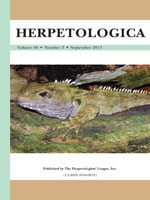A new species of the colubrid genus Geophis from northern Puebla, Mexico, is described. The new species possesses most of the diagnostic characters of the G. dubius group but differs from all other species of Geophis by having the loreal shorter than the combined prenasal and postnasal length, one postocular scale, one supraocular scale, the fifth supralabial and parietal in contact, dorsal scales in 17 rows, dorsal scales smooth throughout the length of the body or, if keeled, not anteriorly to the posterior fourth of the body, 129–140 ventrals in females and 125–139 in males, 26–31 subcaudals in females and 34–39 in males, 159–170 ventrals plus subcaudals in females and 161–174 in males, 9 maxillary teeth, anterior tip of the maxilla toothless, an overall dark dorsum, a predominantly cream venter, and a short tail in males. A Bayesian phylogenetic analysis of mtDNA sequences of the cytochrome b and tRNATrn genes, including representatives of the new species, G. carinosus, G. dubius, and G. juarezi supported the distinctness of the new species.
Se describe una nueva especie del género de colúbridos Geophis del norte de Puebla, México. La nueva especie posee la mayoría de los caracteres diagnósticos del grupo G. dubius, pero difiere de todas las demás especies de Geophis por presentar la loreal más corta que la longitud combinada de la prenasal y postnasal, una escama postocular, una escama supraocular, la quinta supralabial y la parietal en contacto, las escamas dorsales en 17 hileras, escamas dorsales lisas a lo largo de todo el cuerpo o, de ser aquilladas, no anteriormente al cuarto posterior del cuerpo, 129–140 ventrales en hembras y 125–139 en machos, 26–31 subcaudales en hembras y 34–39 en machos, 159–170 ventrales más subcaudales en hembras y 161–174 en machos, 9 dientes maxilares, extremo anterior de la maxila sin dientes, un dorso mayormente oscuro, un vientre predominantemente crema y una cola corta en los machos. Un análisis filogenético Bayesiano de secuencias mitocondriales de los genes que codifican para Citocromo b y tRNATrn que incluyó a la nueva especie, G. carinosus, G. dubius y G. juarezi apoyó la distinción de la nueva especie.





